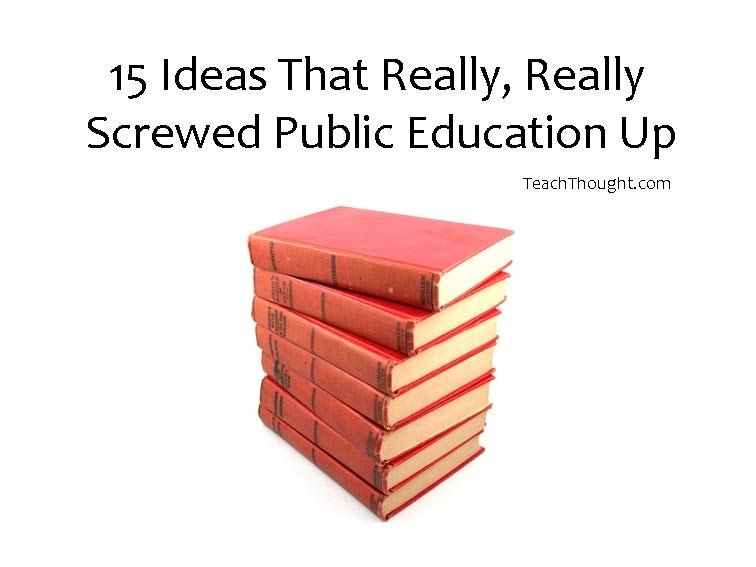There is little need to rehash the argument that public education–in the United States anyway–is utterly broken. For every student that “gets straight As and loves school” there is another is hopelessly lost, and five more than merely endure it. And that’s generously assuming that “straight As” are an indication of having their personalized learning needs met.
So I thought it might be interesting to see how we got to this point–a system that spends billions of dollars a year to offer–at best–an incredibly mediocre service. Note that this, as with almost all writing or thinking of any kind, is just an opinion, and is not an attack at all on any of the human beings who give their all every day to make it all work. I teach, my wife teaches, and most of your writers on staff here teach.
We are in this together.

1. Focusing On Curriculum And Assessment Rather Than Learning Models And Support
This is likely the worst idea public schooling has taken on. The idea here is that by using a standards-based, outcomes-driven, direct instruction model, that real-life content can be parsed without neutering it, understanding be anticipated, and that data can be gleaned and resources shared to improve learning for all. But this only served to homogenize learning in a way that made the world of school entirely different than the world they live and use information in every day.
2. Scripted Curriculum
This is perhaps the most symbolic adoption by public schools struggling to keep teachers and students “on the same page.” For now, let’s skip the desire to have all teachers and students “on the same page,” and focus instead on the idea of a set of learning experience planned in another state by a corporation with zero knowledge of the lives and cognitive identities of students. This falls closely behind #1.
3. Growth
Growing from one-room schoolhouses to sprawling campuses with as many as 5,000 students seems like a natural “development,” but was a recipe for disaster. Size obscures nuance, numbers challenge personalization, and transfer is difficult to coach.
4. Adopting Textbooks
At some point learning left the rolling pastures and arts and humanities, and ended up in textbooks. Textbooks can be excellent sources of information, but they are brutally awful sources of learning.
5. Handing Out Letter Grades
We’ve talked about this one before, but essentially letter grades are overly reductionist—distill impossibly complex realities into a signal symbol that is then over-reacted to by students, parents, and colleges everywhere.

6. Giving Exams
Assessment makes sense; implying that students can adequately demonstrate what they know on a teacher (or corporate)-made exam is, at best, problematic. The point of assessment is to find out what the student understands. This places the onus on the exam, not the student, but unfortunately it has gotten reversed at some point, and now grades and tests trump understanding and learning habits.
7. Busing Students
Hey, here’s a great idea. Let’s wake children up at 6:30 a.m., pile them by the dozen into mass transportation, and ship them into neighborhoods they’ve never seen to be taught by teachers they’ve don’t know. They’ll get used to it.
They’ll be home by 4, in time for parents to patronizingly ask “what they learned in school today” over a rushed dinner, and then ignore the sirens when their child can’t even begin to answer convincingly.
8. Grouping By Age
And once we get them to that school, let’s group them not by theme or project, community or technology, learning model or flexibly, but rather by their date of birth.
9. Adopt One Set Of “National” Standards
So much confusion occurs when Florida sees a standard one way, and Washington another. Some states even see content differently, which means Uncle Sam and corporate America can’t “expect” a common body of knowledge from students. This causes chaos for everyone, and forces Apple to manufacture iPads in China, am I right?
With national standards, now the whole country can gather our resources together to share the burden and improve learning, because getting hundreds of millions of people to work together is so much easier. And think of the economic growth. Intoxicating!
10. Making It Free And Compulsory
Talk about de-valuing a good thing.
Philosophically, this makes sense. And charging for education would seemingly be an even worse idea, but truant officers can tell a different tale entirely. If you have to require something by law, it’s probably being marketed wrong, yes?
11. Creating Learning Conditions That Don’t Require Families And Communities
Many parents know frustratingly little about education—which is why they need to be in the classroom, not pushed away from it, then lured back in twice a year with free chili and balloons.
12. Experimenting With Gender-Based Classes
This one has to be the result of “data,” because only mindless digits would say that separating students by gender is a good idea.
13. Put 30 students In The Room With One Teacher
This one is a matter of economics, I’m afraid. I’ve seen “data” that shows that class size matters little unless you can get the number of students below 15 (so whether you have 17 or 30 doesn’t really impact learning). This should tell us something.
14. Grouping Classes By “Content Areas”
Schooling helpfully categorized the universe into “content areas,” but in doing so made students think they hate stuff—like numbers, ideas, and great thinkers—that they really don’t hate, because year after year they aggregate every teacher, letter grade, test, girlfriend, school, or bad project under the label of a certain “content area” in unconscious acts of misplaced aggression.
15. Government Funding
Anything funded by the government suffers from enough bureaucracy to choke a camel. The same level of innovation and design that went into your local DMV are at work in schools, only schools are staffed with big-hearted and dedicated teachers trying to make it all work. Thus, friction.
Image attribution flickr users woodleywonderworks and wootangclassroom


